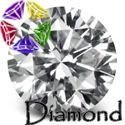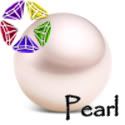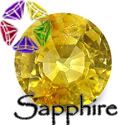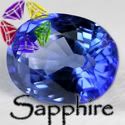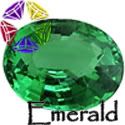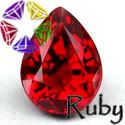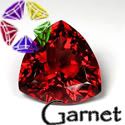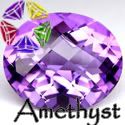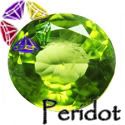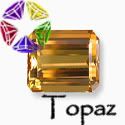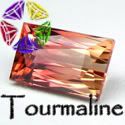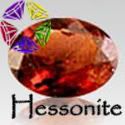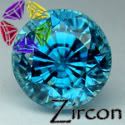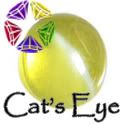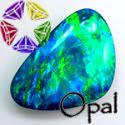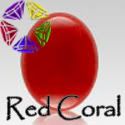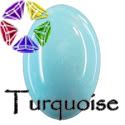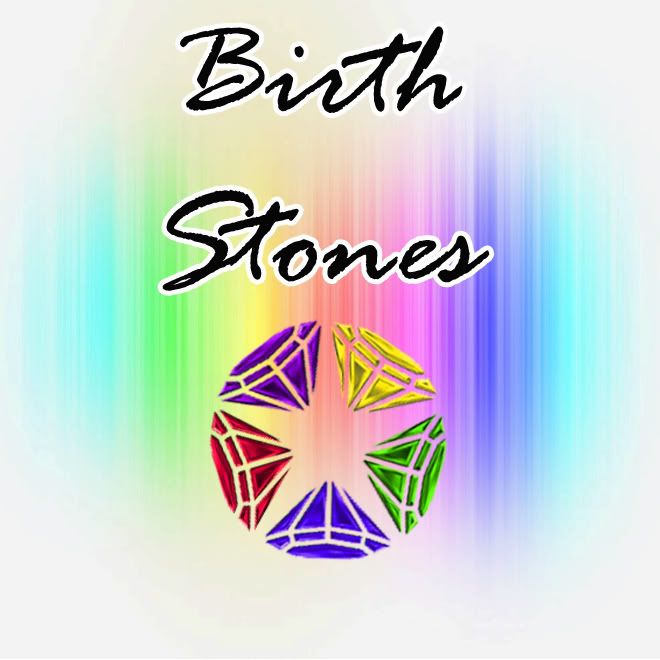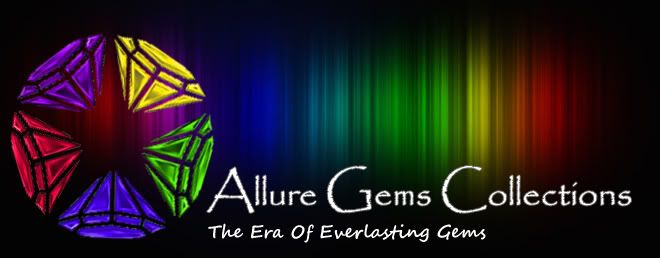
Labels
|

| Astrological Gems | 7:56 PM |
|
Filed under:
Astrological Stones,
Information
|
|
Since the beginning of civilization, gemstones have always been thought to possess metaphysical powers. All the main ancient cultures, Vedic, Egyptian, Mayan, and Greek, had used these colorful and shiny pebbles for ritualistic, sacramental and healing purposes. The idea of using gemstones as solely item of adornment and wealth was a later development; yet, even this shift of perception, had originally an occult reason behind it.
Gems seems to have a special power, a transcendental quality that go beyond their colorful mirror, the thought of far away lands and mysterious places.
In ancient India, a number of Sanskrit texts on gems have been written.
Of a purely scientific, gemological knowledge are works like "Ratnapariksa" (literally 'Gemology'), and "Mani-Mala". More specifically, the "Graha-Gocara Jyautisha", the "Garuda Purana", the "Brhat Samhita", the "Agni Purana" are the texts dealing with planetary gemology.
As we already know, according to Vedic astrology, nine main gemstones are associated with nine planets.
Associated Gems:
with the sun is the RUBY,
with the moon is the PEARL,
with mars is the RED CORAL,
with mercury is the EMERALD,
with Jupiter is the YELLOW SAPPHIRE,
with Venus is the DIAMOND,
with Saturn is the BLUE SAPPHIRE,
with Rahu is the HESSONITE,
and with Ketu is the CAT’S EYE.
It is clearly stated in many passages of the different Vedic texts that "inward luster, transparency, illumination with rays, sparkle, free from impurities and good formation of the shape are the characteristics of good gems" (Agni Purana, 246.13-14).
"Gems are not good if they are sandy, cracked within, scratched, stained, if they are lusterless, rough, dull or mixed with mineral substances even though they may have all the characteristic features of their family" (Garuda Purana, 70.18).
"Since a jewel (gem) endowed with good characteristics ensure good luck, prosperity and success to kings, and one with bad ones, disaster and misfortune, connoisseurs ought to examine their fortune depending on jewels (gems)" (Brhat Samhita, 80.1-3).
"If anyone wears a gem of many flaws out of ignorance, then grief, anxiety, sickness, death, loss of wealth and other evils will torment him" (Garuda Purana, 70.19).
A special attention needs to be addressed to the always-included emeralds. References from the Sanskrit texts claim that emerald inclusions are accepted, as far as the inclusions are not detracting from the overall transparency and beauty of the gem.
"Experts in gems are inclined to say that the following types of emeralds are of good potency: Emerald that has dark green color or the color of a spring meadow, a soft glow, that is not highly complicated (referring to inclusions), hewn in different ways and appear to be stuffed with gold dust (still referring to very small inclusions); emerald that is endowed with qualities of shape, even shade all over, sufficient heaviness and shoots diffusion of light when sun's rays fall on it" (Garuda Purana, 71.12-15)
The use of alternative gemstones is practiced as well, especially for those gems which can be expensive over two carats sizes, such as diamonds and rubies. It is found, however that the alternative gem has a milder effect than the correspondent main gem. See in the table below the alternative gems, metals, and fingers used to wear rings related to the main gem and the correspondent planet.
| Emerald | 3:15 PM |
|
|
|

The Emerald remains one of the most popular gems today and is one of the rarest and most valuable precious stones. Emerald is the astrological, Jyotish gem related to Mercury, which is the planet of intelligence, speech, communication, trade and commerce. Improves learning abilities and clairvoyance and it is beneficial to the nervous system. Wearing a clean emerald of at least 1.5 carat is said to give good results in all the business and trade activities. It will also make the wearer a very persuasive speaker. Emerald can be substituted with peridot, green tourmaline, chrome diopside or chrysoprase of at least 3 carats.Gemological properties
Chemical composition: Be3A12So603 + Cr
Color: From light yellowish green to dark bluish green and everything in between
Hardness: 7.5 - 8
Density: 0.005 - 0.009
Refractive index: 1.577 - 1.593
Birefringence: 0.005 - 0.009
Occurrence: The finest emeralds are from Colombia at Chivor, Muzo, Gachala and Coscuez mines. Other fine emeralds come from Brazil, Zambia, Pakistan, Russia, Tanzanis (Lake Manyara). Colombian emeralds from Muzo and Coscuez can be distinguished in a general way because Muzo material is blue-green, whereas that from Coscuez is yellowish green.
Astrological Properties
Planet: MercuryCosmic Color: Green
Number: 5
Chakra: 1st, Sahasrana
Sign: Gemini & Virgo
Element: Earth
Day: Wednesday
Time: Sunrise
Birthstone for: May
The name emerald is derived from the Greek word Smaragdos meaning "green stone" and, in ancient times, it referred to just about any green colored gemstone. The birthstone for May, emerald is the most prized and precious variety of the gemstone group known as beryl, which also consists of aquamarine and other variations of beryl. Today, most of the world's Emeralds are mined in Columbia, Brazil and Zambia. The green color of emerald is incomparable in the world of gemstones and, for this reason, the color is commonly referred to as "emerald green". The green color in emerald is caused by the presence of chromium in the chemical composition of this particular form of beryl. Under magnification the internal characteristics in an emerald, which include liquid bubbles, gas bubbles, internal stress fractures, and foreign crystals form a virtual garden within the gemstone. Most natural Emeralds contain a variety of these internal inclusions, commonly referred to as "jarden", which is French for garden. Perfection in emerald, as in most all things, is the most rare of nature's treasures. Emerald is the birthstone for May and symbolizes rebirth and youth. Enhancements — When mined from the earth, almost all Emeralds have internal inclusions, or "birthmarks", some of which distinguish them as natural gemstones. Since early times, merchants would purify the color of Emeralds by immersing them in oils or paraffin, which would fill the fissures that were open at the surface and render them almost invisible to the naked eye. Along with the use of oils and resins, there are much more sophisticated techniques being used today to clarity enhance Emeralds.
| Yellow Sapphire | 3:06 PM |
|
Filed under:
Astrological Stones,
Collections,
Information,
Precious Stone,
Sapphires,
Yellow Sapphire
|
|
 Yellow sapphire is the astrological, Jyotish gem related to Jupiter, which is the planet of happiness, prosperity, luck and fortune. Jupiter is the significator of wealth, children, government and the grace of God. Promotes general well-being and spiritual knowledge. Wearing a faultless yellow sapphire of at least 1.5 carats is said to bring money and wealth as well as good marriage and childbirth in the case of a married woman. Yellow sapphire can be substituted with yellow topaz, yellow beryl or yellow zircon of at least 5 carats.
Yellow sapphire is the astrological, Jyotish gem related to Jupiter, which is the planet of happiness, prosperity, luck and fortune. Jupiter is the significator of wealth, children, government and the grace of God. Promotes general well-being and spiritual knowledge. Wearing a faultless yellow sapphire of at least 1.5 carats is said to bring money and wealth as well as good marriage and childbirth in the case of a married woman. Yellow sapphire can be substituted with yellow topaz, yellow beryl or yellow zircon of at least 5 carats.Gemological properties
Chemical composition: AL2O3 (aluminun oxide)
Color: Any shade of yellow, from pale yellow color to dark orangish golden to greenish yellow
Hardness: 9
Density: 4.00
Refractive index: 1.762 - 1.770
Birefringence: 0.008
Occurrence: Sri Lanka, Burma, Thailand, Cambodia, Australia, East Africa, USA.
Species: Corundum
Astrological Properties
Planet: JupiterCosmic Color: Light Blue
Number: 3
Chakra: 2nd, Ajna
Sign: Sagittarius & Pisces
Element: Ether
Day: Thursday
Time: Sunset
Sanskrit Names
Pusparaga (Yellow Sapphire)Guru-Ratna (Gem of Guru)
Puspa-Raja (King of flowers)
Vascapati (Beloved of Jupiter)
Prevention of Diseases
Liver complaints, jaundice, dropsy, flatulence, dyspepsia, abscess, disorders of pancreas, tumors, skin troubles, cerebral congestion, catarrh, circulation of blood in the arteries and fat in the body.| Cat's Eye | 2:50 PM |
|
|
|
 Cat's eye chrysoberyl is the Jyotish gem related to Ketu (the moon's descending node) which is a shadowy entity called Moksha Karaka or "planet of enlightenment". It gives very fine spiritual tendencies, asceticism, non-attachment and psychic powers as well. It is related to ghosts, spirits and astral forces. Wearing a cat's eye chrysoberyl of at least 1.5 carats is said to exalt spirituality and psychic ability, and protect from mysterious dangers and diseases. It brings fortune to gamblers. A cat's eye chrysoberyl can be substituted with cat's eye tourmaline or cat's eye opal of at least 4 ct.
Cat's eye chrysoberyl is the Jyotish gem related to Ketu (the moon's descending node) which is a shadowy entity called Moksha Karaka or "planet of enlightenment". It gives very fine spiritual tendencies, asceticism, non-attachment and psychic powers as well. It is related to ghosts, spirits and astral forces. Wearing a cat's eye chrysoberyl of at least 1.5 carats is said to exalt spirituality and psychic ability, and protect from mysterious dangers and diseases. It brings fortune to gamblers. A cat's eye chrysoberyl can be substituted with cat's eye tourmaline or cat's eye opal of at least 4 ct.Gemological properties
Chemical composition: A12(BeO4) Beryllium Aluminum Oxide
Color: Light greenish yellow, green, brownish green, brownish yellow, brown
Hardness: 8.5
Density: 3.70 - 3.72
Refractive index: 1.744 - 1.755
Birefringence: 0.011 double refractive
Occurrence: Sri Lanka, Tanzania, Brazil, China, Russia
Astrological Properties
Planet: KetuCosmic Color: Infra-red
Number: 7
Sign: Pisces
Element: Water
Day: Thursday
Time: After Sunset
Sanskrit Names
Ketu-ratna (Ketu's gem)Vaidurya (Cat's eye)
Sutra-mani (Thread-jewel)
| Hessonite | 2:40 PM |
|
|
|

Hessonite garnet ("Gomeda" in Sanskrit) is the Jyotish gem related to Rahu (Moon's ascending node), which is mainly an elemental and instinctual entity. When badly positioned, this "shadow planet" is characterized by insatiable worldly recognitions and desires together with sense gratification. Wearing a hessonite of at least 2 carats is said to bring success, wealth and notoriety in society, increase life span and good fortune. Hessonite can be substituted with orange zircon.Gemological properties
Chemical composition: Ca3A12(Si04)3
Color: From light yellowish orange to dark brownish orange and dark orange-red
Hardness: 7 - 7.5
Density: 3.60 - 3.68
Refractive index: 1.738 - 1.745 Single refractive
Occurrence: Sri Lanka, Canada, Brazil, East Africa, Madagascar
Astrological Properties
Planet: RahuCosmic Color: Ultraviolet
Number: 4
Sign: Aquarius
Element: Ether
Day: Saturday
Time: Sunset
Sanskrit Names
Gomeda (Cow's unrine colored gem)Rahu-ratna (Rahu's gem)
Pita rakta mani (Orange gem)
Tamo-mani (Rahu's jewel)
Prevention of Diseases
Cancer, fears, phobias, undiagnosable illness, poisons| Red Coral | 2:30 PM |
|
|
|

Red coral is the Jyotish gem related to Mars, which is the planet of ambition, motivation and desire. It rules physical strength, forcefulness, energy and passion. Wearing a red coral of at least 2 carats is said to remove obstacles, avert warfare, purify the blood and cure boils. It will make the wearer courageous yet prudent. Red coral can be substituted with carnelian of at least 5 carats.Gemological properties
Chemical composition: CaCO3 (primarily mineral calcite)
Color: Flesh pink, pale to deep rose red, salmon pink, red to dark ox-blood red (this one being the most rare and priced)
Hardness: 3.5 - 4.0
Density: 2.6 - 2.7
Refractive index: 2.417
Occurrence: Throughout the Mediterranean Sea and Red Sea areas, Spain, Morocco, Malaysia, Japan. The most important center for the fishing and manufacturing of the finest red coral is Torre Del Greco (Italy).
Astrological Properties
Planet: VenusCosmic Color: Yellow
Number: 9
Chakra: 7th, Muladhara
Sign: Aries & Scorpio
Element: Earth
Day: Tuesday
Time: Sunrise
Sanskrit Names
Munga (Red Coral)Bhauma-ratna (Gem of Mars)
Vidruma (The coral tree)
Abdhijantu (Being of the ocean)
Prevention of Diseases
Eruptions of the face and body
Cuts, burns, bruises
General diseases of the blood, muscular system, bone marrow
| Diamond | 2:20 PM |
|
|
|
Diamond
 Diamond is the Jyotish gem related to Venus, which is the planet of love, beauty, arts and married life. Like Jupiter, it bestow money, comforts and fortune on a person when it is strong and significantly well placed. It can be useful in the cure of venereal and reproductive system diseases. Wearing a fine white sapphire of at least 2 carats and a damburite of a t least 3 ct., is said to bestow happiness in married life as well as magnetism and attractiveness for the wearer.
Diamond is the Jyotish gem related to Venus, which is the planet of love, beauty, arts and married life. Like Jupiter, it bestow money, comforts and fortune on a person when it is strong and significantly well placed. It can be useful in the cure of venereal and reproductive system diseases. Wearing a fine white sapphire of at least 2 carats and a damburite of a t least 3 ct., is said to bestow happiness in married life as well as magnetism and attractiveness for the wearer.Gemological properties
Chemical composition: Pure carbonColor: Colorless to hues of brown, yellow, pink, chartreuse, blue, etc. The most priced diamond are those classified as colorless and "fancy"
Hardness: 10
Density: 3.52
Refractive index: 2.417
Occurrence: South Africa, Angola, Botswana, Australia, Russia, India, Brazil, Venezuela.
Astrological Properties
Planet: VenusCosmic Color: Deep blue
Number: 6
Chakra: 3rd, Vishuddhi
Sign: Taurus & Libra
Element: Water
Day: Friday
Time: Sunrise
Sanskrit Names
Vajra (Lightning bolt)Hiraka (Diamond)
Bhargava-priya (Beloved of Venus)
Birthstone for: April
April's birthstone is the diamond. Diamonds are a wonder of nature. Their cold sparkling fire has held us spell-bound for centuries, inspiring rich passionate myths of romance, intrigue, power, greed, and magic. Ancient Hindus, finding diamonds washed out of the ground after thunderstorms, believed they were created by bolts of lightning. In our place and time, the diamond is a symbol of enduring love, and often grace engagement rings.
There are many kinds of diamonds: transparent, translucent or opaque; ranging from colorless to sooty black, with many colors in between. Mostly transparent diamonds, colorless or tinted, are used as jewelry. Others are used widely in industry.
The color of a diamond depends on the kind of impurities embedded inside it. Yellow diamonds, for example, betray minute quantities of nitrogen, while boron imparts a bluish hue.
There are other inclusions in diamonds that have great scientific value. Such samples are time capsules that yield valuable information about conditions deep in the Earth's upper mantle where diamonds formed, and yield clues to the formation and age of the diamond.
Diamonds are the rich cousins of graphite, both crystalline forms of pure carbon. The enormous differences in their properties is a result of the way that carbon atoms are bonded together. In graphite, carbon atoms are arranged in sheets that easily slide past each other, making them ideal as lubricants and of course, pencil leads. Diamond crystals, on the other hand, are a tight-fisted network of carbon atoms securely held in four directions, making it the hardest naturally-occuring substance in the world. In order to achieve such a compact and strongly-held network of carbon atoms, it is believed that diamonds must have crystallized deep under the Earth's surface. At these depths exist the proper conditions for the formation of diamonds; at 90 to 120 miles deep, pressures are more than 65,000 times that of the atmosphere at the Earth's surface, with temperatures exceeding 2,700 degrees Fahrenheit. Such pressures and temperatures reproduced in laboratories have successfully yielded synthetic diamonds. Diamonds are found in alluvial deposits, that is, gravel swept by streams, rivers, glaciers and ocean currents. They are also found in sedimentary rock where gravel deposits and organic material have been compressed into rock. Diamonds can be found in some samples of kimberlite -- a type of volcanic rock first identified in Kimberly, South Africa. Diamonds found in kimberlite are thought to be very old, perhaps as much as three billion years old. Tiny flecks of diamond have even been found inside meteorites -- bits of rocky space debris that land on Earth. Diamonds are crystals, crystals being the ultimate form of symmetry in nature.
The shape of the crystal reflects the internal orderly arrangement of atoms within it. In diamonds, atoms of carbon are held tightly by covalent bonding, where two neighboring atoms share an electron, endowing the diamond crystal with great strength. But despite its hardness, diamonds can be cut. This is accomplished by cutting the gem along planes parallel to the faces of the crystal where the tight bonds between carbon atoms are a little weaker. Found in their natural form, diamonds can appear quite unimpressive. It is only when they are cut and polished by skilled craftsmen, such that the light entering it is reflected and refracted as best possible, only then is their hidden beauty revealed.| Pearl | 9:14 AM |
|
|
|
Pearl
 Pearl is the traditional birthstone for the month of June. It is unique among the gemstone world as the only gem formed in a living creature. An old Arabian legend believed Pearls were formed when dew drops of moonlight fell into the ocean and were swallowed by oysters. Native American Indians have long used Pearls found in the Mississippi River in their necklaces, headdresses and copper ornaments.
Pearl is the traditional birthstone for the month of June. It is unique among the gemstone world as the only gem formed in a living creature. An old Arabian legend believed Pearls were formed when dew drops of moonlight fell into the ocean and were swallowed by oysters. Native American Indians have long used Pearls found in the Mississippi River in their necklaces, headdresses and copper ornaments.Pearl is also the astrological, Jyotish gem related to the Moon, which represents the psyche in man, ruling conscious and unconscious depths. It is associated with the mother and childhood and it rules peace of mind, comforts and the general well-being and fortune of a person. Wearing a pearl of at least 3 carats is said to bring fortune, recognition and fame to its wearer. It can be beneficial to any disease of the breast and brain. Pearl can be substituted with moonstone of at least 3-4 carats or more.
Gemological Properties
Color: The color of a pearl is the result of a body color and an overtone color (known as orient) present (due to surface effects) as a lustrous sheen. White, light cream, light rose, light yellow, blue and green overtones on a white body, black and colored pearls.
Hardness: 2.5-4.5
Density: 2.6-2.78; conch pearl, 2.85; cultured pearls, 2.72-2.78, i.e., heavier than most natural pearls, but this is not a diagnostic fact.
Occurrence: saltwater pearls are the most important on the market place. These come principally from the Persian gulf (coasts of Iran, Oman, Saudi Arabia and Bahrain State), Gulf of Manaar ( an arm of the Indian Ocean between India and Ceylon), Australia, South Seas, Japan, Venezuela. Freshwater pearls come from rivers throughout the world.
Astrological properties
Cosmic Color: Orange
Number: 2
Chakra: 10th, Svadtistana
Metal: Silver or white gold
Sign: Cancer
Element: Water
Day: Monday
Time: Evening
Sanskrit Names
Mukta (Pearl)Sasi-ratna (Gem of the moon)
Taraka (Falling star)
Jiva-ratna (Gem of the intellect)
Signs of a well-placed Moon
The native will have good affluence, good fortune, recognition and fame.
Emotions under control.
Good memory.
Balanced emotional life.
Prevention of the following diseases
Eye diseases, lunacy, paralysis, hysteria, epilepsy, cold, cough,
Colic pains, worms, intestinal disorders, tumors, peritonitis,
Throat troubles, asthma, bronchitis, varicose loins, nervous debility, cancer, typhoid
Birthstone for: June
The pearl is unique in the world of gemstones, as it is the only gemstone that is formed within a living creature. Known as the birthstone for the month of June, pearls are truly a treasured gift of the sea and revered for their colors, shapes, sizes and luster. As the supply of naturally occurring pearls became exhausted man learned how to cultivated them by implanting an irritant into oysters, which produced pearls having the same outer appearance as their natural counterpart. Cultured pearls are grown and harvested in many parts of the world, including the fresh waters of the Tennessee River, and are available in many beautiful colors, from the palest crème and white to rose, lilac, green, gold, gray and the dramatic Tahitian black. The majority, however, come from Japan, China and the South Pacific. Today, the pearls from the Japanese Akoyah oysters are becoming the most prized, as unfavorable biological and environmental conditions have reduced the availability of larger and finer quality pearls from the salt waters of Japan. Human innovation, however, has compensated for natures hardships as man has perfected the cultivation of the larger freshwater oysters in the lakes of China, producing an abundant crop of beautiful cultured pearls ranging from lustrous white to naturally occurring soft pastel colors.
To find beautiful pearls in much larger sizes, exceeding nine and ten millimeters in diameter, one must look to warm waters of the South Pacific where magnificent whites from Australia and dramatic natural blacks from Tahiti are harvested to produce one-of-a-kind necklaces or combined with diamonds for truly magnificent pieces of jewelry. In the cultivation process of all pearls man can only begin the process by implanting an irritant within the muscle of the oyster. After that it is up to the mollusk to produce a fine gem, a very poor gem, or something in-between. Similar to the way any gemstone is judged, the value of any pearl will depend on rarity, beauty, size, color, luster and degree of perfection. In the case of a strand of pearls, the quality of how well the pearls are matched is also an important consideration. In the world of pearls there is something for everyone.
Enhancements — Today, cultured and freshwater pearls are often bleached to achieve a uniform color. Sometimes they may be polished in tumblers to achieve better roundness and luster.
| Rubies | 4:41 AM |
|
|
|
Ruby
 Ruby is the astrological, Jyotish gem related to the Sun, which rules one's person confidence, authority, power and status. The Sun is related to the soul and has a great deal to do with career and the person's worldly activities. Wearing a ruby of at least 1 carat is said to increase popularity and professional status. It will cure diseases of the eyes and of the heart. Ruby can be substituted with red spinel, red garnet (Rhodolite) or red tourmaline of at least 3 carats.
Ruby is the astrological, Jyotish gem related to the Sun, which rules one's person confidence, authority, power and status. The Sun is related to the soul and has a great deal to do with career and the person's worldly activities. Wearing a ruby of at least 1 carat is said to increase popularity and professional status. It will cure diseases of the eyes and of the heart. Ruby can be substituted with red spinel, red garnet (Rhodolite) or red tourmaline of at least 3 carats.
Gemological Properties
Chemical composition: AL203 + Cr (aluminum oxide)Species: Corundum
Hardness: 9
Refractive index: 1.763-1.770
Density: 3.99-4.1; usually near 4.00
Pleochroism: Strong dichroism
Birefringence: 0.008
Color: Any shade of red, from light pinkish red to dark purplish red. In ancient times, pinkish red rubies were called Padmaraga (red as the lotus) or Feminine rubies, while dark red rubies were considered Masculine stones.
Occurrence: -Burma- Burmese rubies historically comes from the Mogok stone tract. The history of mining in Burma is long, complex and turbulent and date back thousands of years. Gems occur in a gravel layer called Byon at a dept of 20 to 100 feet, and are recovered by rudimental washing and screening and then hand-picking of encouraging-looking pebbles. Today, the Mong Hsu tract is also producing gem quality stones. Very fine Burmese stones over 5 carats are today extremely rare and can command ten times as much the price of a 5 carats diamond. Other producers of fine rubies are Thailand, Pakistan, Vietnam, Ceylon, East Africa.
Astrological-Healing Properties
Planet: SunCosmic Color: Red
Number: 1
Chakra: 5th, Manipura
Metal: Yellow gold
Sign: Leo
Element: Fire
Day: Sunday
Time: Sunrise
Sanskrit Names:
Manikya (Ruby)Padmaraga (Red-lotus color gem)
Shona-Ratna (Red jewel)
Ravi-Ratna (Gem of the sun)
Signs of a well-placed Sun
Creative, vital, resistant, determined and decisive.
Successful activity, authority.
Royalty, high position in administration.
Cheerful outlook, good fortune, ambition to achieve great heights, brilliance, optimism, success in worldly affairs.
Prevention of the following diseases
Heart diseases, eye inflammation, low or high blood pressure,
Hemorrhage, cardiac thrombosis, heated and bilious constitution
Cerebral meningitis, eruption of the face, typhoid, polypus, epilepsy, bile complaints, sun-stroke, scorches, diseases of the head
Birthstone for: July
Ruby, "the King of Gems" and birthstone for July, gets it's name because of its red color and is derived from the Latin word Rubeus, meaning red. It was discovered around 1800 that Ruby, as well as sapphire, belonged to the same mineral group, or species, called corundum. Prior to that date, both red spinel and garnet were thought to be, or were referred to, as Ruby. In fact, many of the most prominent red gemstones in England's Royal Jewels are magnificent red spinels which, for years, were thought have been rubies. The red color in Ruby is derived from chromium and historically, the most desirable ruby color is denoted by the term "pigeons blood". The red color of Ruby will vary from deposit to deposit and it is, therefore, not possible to determine the source area of a Ruby based on its color. Ruby is mined throughout Southeast Asia and while the majority is found in Thailand and Myanmar (Burma), many exquisite gems also are found in Sri Lanka and Africa. The designation Burmese-ruby or Siam-ruby are trade names and refer more to color quality than to actual origin. Internal characteristics, or inclusions, are very common and while these inclusions are not necessarily indicative of lower quality, they may show the difference between natural and synthetic. Certain types of inclusions may also indicate the source area, or origin, of the gemstone.
Enhancements — As is the case with many colored gemstones, Rubies are routinely enhanced to improve their color and their clarity, the most notable being controlled heating. Many enhancement procedures are generally recognized and accepted throughout the jewelry industry and, in most cases, these enhancements are irreversible, permanent, and will produce a gemstone that is more beautiful. One should be leery, however, of enhancement techniques that are not permanent. If you intend to purchase any fine colored gemstone you should deal with a jeweler who is gemologically trained to explain the differences.| Blue sapphire | 1:00 AM |
|
Filed under:
Astrological Stones,
Birthstones,
Blue Sapphire,
Collections,
Information,
Precious Stone,
Sapphires
|
|
Blue Sapphire
 Sapphire is the traditional birthstone for the month of September. Sapphire has long been the symbol of the sky and heavens, the guardian of truth and the protector of chastity. The ancient Persians held the belief that the entire world rested on a sapphire and its reflection is what made the sky blue. Sapphires have had a long history of being engagement gifts among royalty and nobility. This includes the widely popular Lady Diana Spencer who received a blue sapphire and diamond ring upon her engagement to Prince Charles. In blue, sapphire ranges from a very light pale blue to vivid violet blue to a deep midnight blue.
Sapphire is the traditional birthstone for the month of September. Sapphire has long been the symbol of the sky and heavens, the guardian of truth and the protector of chastity. The ancient Persians held the belief that the entire world rested on a sapphire and its reflection is what made the sky blue. Sapphires have had a long history of being engagement gifts among royalty and nobility. This includes the widely popular Lady Diana Spencer who received a blue sapphire and diamond ring upon her engagement to Prince Charles. In blue, sapphire ranges from a very light pale blue to vivid violet blue to a deep midnight blue.
Blue sapphire is the Jyotish gem related to Saturn, which is the planet of wisdom, integrity and discipline. It rules responsibility, leadership, ambition and wisdom born of experience. It's also the planet of renunciation and spiritual journey. Wearing an unheated blue sapphire of at least 1.5 carats is said to bring discipline and bestow the ability to govern and lead others. Blue sapphire can be substituted with blue spinel, amethyst, blue tourmaline of at least 3-4 carats.
Gemological properties
Chemical composition: AL2O3 + FeHardness: 9
Density: around 4
Refractive index: 1.762-1.77
Birefringence: 0.008
Pleochroism: Strong dichroism
Color: Light blue to dark blue, violetish-blue, greenish-blue, steely-blue, color change from blue or greenish blue to violet-purple to purple.
Occurrence: Sri Lanka, Thailand (Kanchanaburi), Cambodia (Pailin), Burma, Kashmir, Australia (Anakie), Tanzania, Madagascar, USA (Montana, Yogo Gulch).
Astrological properties
Planet: SaturnCosmic Color: Violet
Number: 8
Chakra: 4th, Arahata
Sign: Capricorn
Element: Air
Day: Saturday
Time: Sunset
Sanskrit Names
Nilam (Blue sapphire)Nila-mani (Blue jewel)
Indra-nilam (Royal blue gem)
Sani-ratna (Saturn's gem)
Signs of a well-placed Saturn
Wisdom, integrity, discipline, spiritual achievement trough humility, patience, dedication and non-attachment.
Saturn also govern leadership and perfection, highest human qualities, and longevity.
Prevention of the following diseases
Paralysis, asthma, rheumatisms, teeth problems, bones problems.
Birthstone for: September
Birthstone for the month of September, the name Sapphire comes from the Greek word "Sappheiros", meaning blue. However, sapphires are formed in nature in a literal rainbow of colors, ranging from very light to very dark blue, bluish green, yellow, brown, pink, violet, slightly reddish orange, and a fabulous pinkish-orange that is referred to as "padparadscha". The name padparadscha is derived from the Sinhalese for "lotus flower". The mineral name for sapphire is Corundum and its pure red form it would be known as ruby. The finest sapphire color in the blue hues is a rich, velvety, cornflower blue known as "Kashmir", which references the area of India where these precious gemstones were once mined. Most current production comes from Sri Lanka, Burma, Thailand, Australia, Africa and Montana. Sapphire will sometimes occur in nature in such a way whereby numerous needle-like inclusions within the gemstone are oriented in just the right angles within the stone, to produce a phenomenon that is called "asterism". As such a six-pointed star will appear to float just beneath the surface of the gemstone when subjected to an incandescent light source. These gemstones will always range from translucent to opaque and they depend on the cutters art to fashion them into a polished, domed shape known as "cabochon".
Enhancements — As is the case with many colored gemstones, sapphires are routinely enhanced to improve their color and their clarity, the most notable being controlled heating. Many enhancement procedures are generally recognized and accepted throughout the jewelry industry and, in most cases, these enhancements are irreversible, permanent, and will produce a gemstone that is more beautiful. One should be leery, however, of enhancement techniques that are not permanent. If you intend to purchase any fine colored gemstone you should deal with a jeweler who is gemologically trained to explain the differences.Order/Enquiry Form

© 2008 Allure Gems Collections
Redesign by DevilCp
Design by Templates4all
Converted to Blogger Template by BloggerTricks.com
